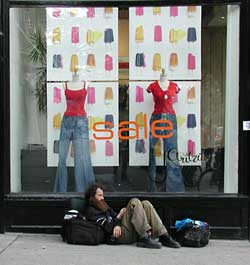Out of Style
With economic uncertainty forcing consumers to reconsider how they spend, Molly Doyle discovers that fashion magazines are changing the way they dress up their stories. But that may not be enough to keep them publishing
Fashion journalism hopes to help transform the “fashionista” into a “recessionista,” as a recent New York Times article put it, by highlighting the recent trend towards staying stylish on a tighter budget. Here in Canada, for example, the cover of Fashion‘s November issue features a big, bold pink-and-white sell line that promises, “Luxury for less— when to spend, where to save.”
The magazine had planned for a year to do a luxury issue, but as the economy faltered, editor-in-chief Ceri Marsh and her staff realized it made more sense to spin the story another way. “Obviously the economy is top of mind right now for everyone,” she says. “Any kind of big moment like that in the culture, it’s your job to reflect it.”
But reflecting a culture shift caused by an economic downturn could prove to be a lot easier than surviving that downturn. Already Wish, a lifestyle magazine with a fashion section, has announced that it will cease publication in December. Meanwhile, many Canadian fashion titles are facing worrisome slides in ad sales. And it’s one thing to go from being a fashionista to becoming a recessionista, but no publication wants to be a depressionista.
Articles such as “Luxe for Less” or “100 Items for Less Than $250” have always been staples for fashion magazines and newspaper style sections, but in good times readers had to look a little harder for them. That’s all changed. Marsh cites examples in the November issue of Fashion: “You’ll find both ends of the style see-saw-from the fashion-for-the-people collaboration between Comme des Garçons and H&M to fall’s glittering shower of fine and costume jewellery. And in the interest of bringing you the most opulence for your buck, we’ve put together a list of the season’s best pieces-under $500.”
Gucci, Dolce & Gabbana and other high-end designers-with their high-end prices-aren’t completely disappearing from fashion spreads. “The rich tend not to suffer as much during recessions,” says Russell Smith, author of Men’s Style: The Thinking Man’s Guide To Dress, freelance columnist for The Globe and Mail and co-creator of xyyz.ca, a website for men with info on entertainment, style, dining, sports, health and cars. “But it’s not only the rich who read about these products, fashions and lifestyles that they can’t afford. It’s everyday people.” He believes lavish spreads are for people to fantasize about and escape to another world where they could afford to wear over-the-top, glamorous clothes. “It’s called an aspiration spread. It’s not practical. It’s about imagining yourself in that situation,” explains Smith. “That’s why they’ll show the $20,000 dress on a model who is 18-years-old and she’s riding on an elephant in a palace in India.”
But as advertising budgets shrink, spreads of any kind will be less common because issues will be smaller and some publications may fail. Wish, will suspend publication at the end of the year, though its website will continue, as will an annual magazine that will include easy weekday recipes and grocery lists from the magazine’s popular 20-Minute Supper Club.
Other Canadian fashion magazines are also suffering. A comparison of ad pages, including inserts and supplements, from the third quarter in 2007 to the third quarter in 2008 shows that Flare ad pages plunged 44.2 per cent, Fashion dropped 20.3 per cent, and Elle Canada slipped 5.7 per cent, according to Leading National Advertisers of Canada (LNA). Toiletries represent the biggest advertising category for Canadian consumer magazines, and for women’s titles in particular. Toiletry ad dollars were down 24.9 percent in the third quarter of 2008, according to Marco Ursi, editor of Masthead.
Core advertisers prefer ‘pure fashion’ magazines to publications that just include fashion in their mix, as Wishdid. “Part of the problem with Wish is that it was a kind of a schizophrenic idea,” speculates Ursi. “It worked for a while, but when things get tough and you’re trying to pull from four different ad categories, what happens is you end up lower on the ad buyer’s list.”
Douglas Knight, president of St. Joseph Media, the company that published Wish and Gardening Life, which also closed, is not optimistic about the short-term prospects for the magazine industry. “This is the largest blow-off in advertising. This is my fourth downturn; there’s never been one like this before,” he says. “Over a dozen magazines closed this fall, and this is just the beginning.”















